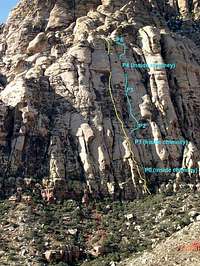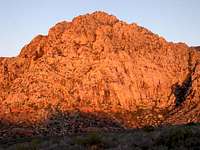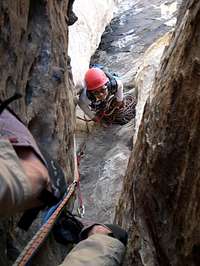|
|
Route |
|---|---|
|
|
36.16860°N / 115.4947°W |
|
|
Trad Climbing |
|
|
Spring, Summer, Fall, Winter |
|
|
Half a day |
|
|
5.7 (YDS) |
|
|
5.7 [5.6R] |
|
|
6 |
|
|
III |
|
|
Approach
The route "shadows" its more famous neighbor - Tunnel Vision - about 50 to 100 yards on the right. It is of similar length as Tunnel Vision but somewhat different in the nature of climbing. To reach the base of the route, follow the directions on Josh's Tunnel Vision page. When you're about 100 feet below the start of Tunnel Vision, find a climbers' trail that traverses rightward below the base of Angel Food Wall. Do not go to the base of Tunnel Vision and then try to traverse right below the base of the rock - you'll be faced with some drop offs and much much brush!! Take the climbers trail mentioned above for about 75 to 100 yards as it traverses right and uphill getting progressively closer to the rock base. The route starts in a shallow, right-facing dihedral. There's a large tree 30 feet above the base at the mouth of a prominent chimney (see photo for start).
Route Description
The route climbs next to Tunnel Vision and reaches the same 3rd class gully/ledge system midway up the face of White Rock Mountain. Despite the advertised (in Supertopo and Swain) OW nature of climbing on this route, much of the climbing actually happens on the well-featured face outside the OW (which iteslf is fairly low angle). There might be a total of one or two "mandatory" arm bars on the entire route. The runouts on .7 terrain are avoidable with large gear (like #4.5, 5 Camalots or Big Bros). The runouts on easier terrain (.5 and .6 faces) are pretty much unavoidable. Note that the pitch lengths and difficulty ratings came from the Supertopo on Red Rocks.
Note: Sergio mentions that the route definitely deserves a 5.7R rating. Weigh the opinions & give me feedback & I'll put it in here. Thanks!
Pitch 1: 5.6, 130 feet. Climb up the shallow right facing dihedral for about 20-30 feet until on a ledge (with a large tree) at the mouth of a large chimney system. Do not take the chimney. Instead, climb up and leftward (small crack for pro...it fades early on) onto the face. Follow the face to an "alcove" (3X2 foot ledge with some bulges around it) overlooking the large chimney on the right. Look around, there's decent gear anchor opportunity (2-3.5inch range). Note that the 5.6 climbing on the face is pretty run-out. I was able to place two pieces on the face portion above the dihedral. Don't fall!
Pitch 2: 5.7, 80 feet. Though it's not obvious from the Supertopo, move LEFT (not directly up what appears to be a good hand crack...it fades 15 feet above the alcove) and up easy chimney which shortly turns into an off-width. Continue up this easy OW (face climbing mostly) until you reach a good ledge at the base of a low angle slab. The pro used on this pitch consisted of cams ranging from a #3 to a #5 Camalot. If you have those, the pitch is not really run out.
Pitch 3: 5.4, 90 feet. From belay, move up following a hand crack for about 20-30 feet and then traverse left on the face to reach a groove/gully on the left side of the low angle slab. Follow it to the ledge above (with a big boulder on top)
Pitch 4: 5.5, 80 feet. Follow the low angle face with wide crack directly up to the comfy (but small) belay alcove with a small tree. Note that P3 and P4 can be combined with a 60m rope and about 10-15 feet of simulclimbing.
Pitch 5: 5.5, 80 feet. Move directly up the low angle dihedral/crack/chimney. This is easy but fairly runout even with largest gear. Belay at the base of a roof in a small cave-like thing (gear). It's spacious enough for two at most.
Pitch 6: 5.7, 180+ feet. Move up the chimney directly above traversing right where the chimney tapers (15 feet above belay). Face climb and stem your way directly above (~5.7). Traverse right on the face when the angle eases back a bit and reach the base of a bulging crack. This might be the crux of the route but it's not harder than 5.7 (runout P1 was the mental crux IMHO). Move up the bulging crack which quickly turns into a wide groove and the angle kicks back. Belay on top.
Descent:
From top of route, follow slabby boulders left about 100 feet to reach the top of Tunnel Vision. Do not enter the class 3 gully/chimney system directly behind where the route tops out or you'll have to do one rappel. The walk-off gully (same as descent for Tunnel Vision) starts lower (and it runs parallel and to the LEFT of the gully you see at the top of Group Therapy) and involves no rappels (you'll should never feel inclined to reach for the rope). Scramble down this gully for a few hundred feet (under a chockstone or two) until its end. Traverse narrow and a bit exposed ledges right (this is where the other gully would deposit you with a rappel). You're now at the top of a very large gully. Follow a faint trail to its right side (otherwise...rap's will be involved). Continue following this trail down the large gully (switchbacks qutie a bit and involves nothing harder than class 3) and it'll deposit you at the base of Angel Food Wall. If you left stuff at the base of the climb, follow a good trail left at the base of the rock. Otherwise find one of many social trails heading towards the wash and the dirt road/trail on the other side.
Backing off this route is not really a good option. Gear will need to be left behind (unless you can downclimb 5.7).
Essential Gear
Cams - if you have some large ones, bring them. Used up to a #5 Camalot (just because we had one with us). Think I'd be pretty comfortable with a #3.5 and some runout on fairly easy terrain. 60m rope is useful. Helmets are always good.












